I had always imagined Egmont Key, an island in the mouth of Tampa Bay, to be a place far from the crowds: remote, wild and natural, and it has always intrigued me.
We loved our day on Egmont Key, but it wasn’t what we expected.
It’s a popular destination for people arriving both by ferry and private boat, so it isn’t empty. And while the beach is beautiful, it really isn’t any nicer than the beaches of Anna Maria Island to the south or Pass-a-Grille to the north, and it is far from deserted.

What is special, though, is the intriguing history you experience here. If you like visiting crumbling old forts or ghost towns in a jungle, as I do, then Egmont Key makes a splendid adventure.
Egmont Key is preserved as Egmont Key National Wildlife Refuge and is jointly managed with the state, which operates Egmont Key State Park here.
But be prepared, because while plenty of people may be on the island, Egmont Key is remote. It has no cars, no drinking water and no bathrooms. You must arrive by boat and, no, you can’t camp overnight.
If you take a ferry, your ticket will be $40 to $70 depending on which your choose, so this isn’t an inexpensive outing.
So is it worth it and why would you go?

Here are a five things I loved about Egmont Key:
- Exploring Fort Dade, which is in a state of romantic ruin.
- Walking the fort’s beautiful red brick roads, which are now lanes through a jungle.
- Encountering so many gopher tortoises. They’re everywhere and when you meet them on the brick roads, they stand their ground.
- Enjoying a picnic at the beach, where we overlooked ruins of Fort Dade’s power plant being engulfed by the Gulf.
- Seeing the simple historic cemeteries by the picturesque lighthouse, where Civil War veterans are buried on one side and lighthouse keepers and their families on the other.
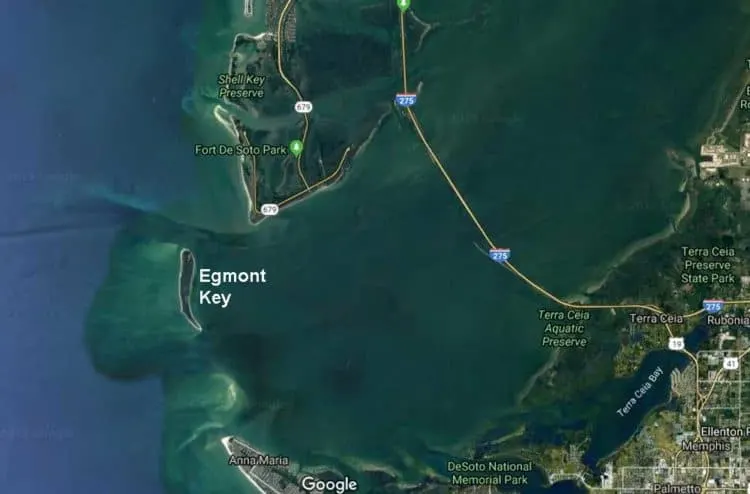
The story of Egmont Key and Fort Dade
Egmont Key is about 1.6 miles from Fort De Soto Park at the bottom of St. Pete Beach, and it’s also about 1.6 miles long.
Much of the bayside waterfront and the southern half of the island is off-limits as part of the bird habitat of Egmont Key National Wildlife Refuge.
Some 25,000 bird pairs nested on Egmont Key in 2020 with 20,000 of those being laughing gulls. Other species include royal and sandwich terns, brown pelicans, black skimmers, and American oystercatchers.
Egmont Key was home mostly to birds up to the middle of the 1800s. Man’s presence was limited to a lighthouse, Seminole Indians imprisoned here during the Third Seminole War and the Union Army occupying it during the Civil War.
In 1898, however, as the Spanish-American War threatened, Fort Dade was built on the island and remained active until 1923. It is these ruins of Fort Dade that you now are allowed to wander.
At its heyday, Fort Dade had 300 residents, red brick roads, electricity, telephones, a hospital, jail, a movie theater, bowling alley and tennis courts. Except foundations and ruins of the sturdy fort batteries, it’s all gone now.
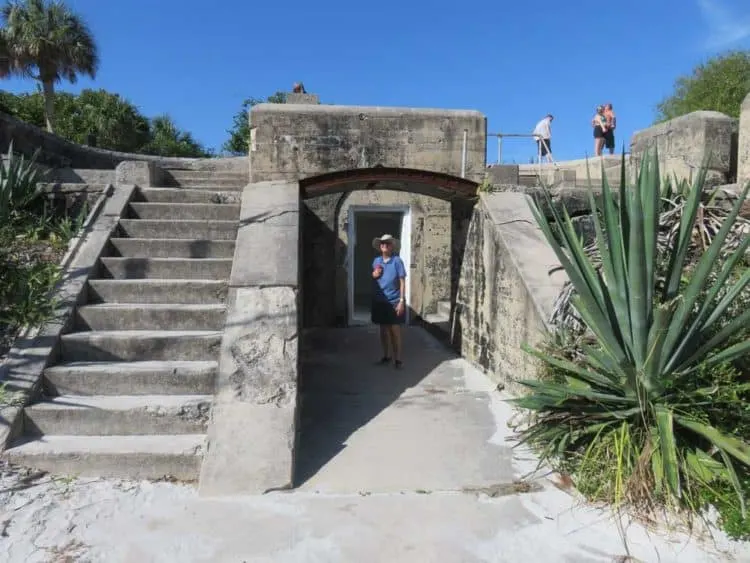
How to visit Egmont Key State Park
There are now two options for taking a ferry to Egmont Key:
The original, a ferry from Fort DeSoto Park takes 20 minutes and allows a three-hour visit. Tickets are $40 for adults: $20 youth 3-11. More information and reservations are here.
The new offering is a ferry providing service from the St. Pete Pier on a larger boat with bathooms called the Pelican. This trip starts with an hour-long boat ride past the St. Petersburg skyline and under the Sunshine Skyway. It allows for two hours on the island with departures at 9 a.m. and 1 p.m. and costs $69 for adults; $49 for kids. Here’s more about the Pelican tour to Egmont Key,
What to expect on an Egmont Key trip
On the Friday after Thanksgiving, we had booked the 11 a.m. ferry from Fort DeSoto to Egmont Key. At this time of year, the company generally runs one ferry a day. But because of the holiday weekend, they had added several other trips, including a 10 a.m. ferry and an 11:30 a.m. ferry.
The Fort DeSoto-Egmont Key ferry is open-air and two-thirds under roof. The trip to the island is about 20 minutes. The ferry ticket allows a three-hour visit with a specific time to board for your return.
In addition to visitors who arrive by ferry, other visitors arrive by power boat, anchoring off the beaches. There were probably 100 power boats on the day we visited, so this was not exactly a deserted island.
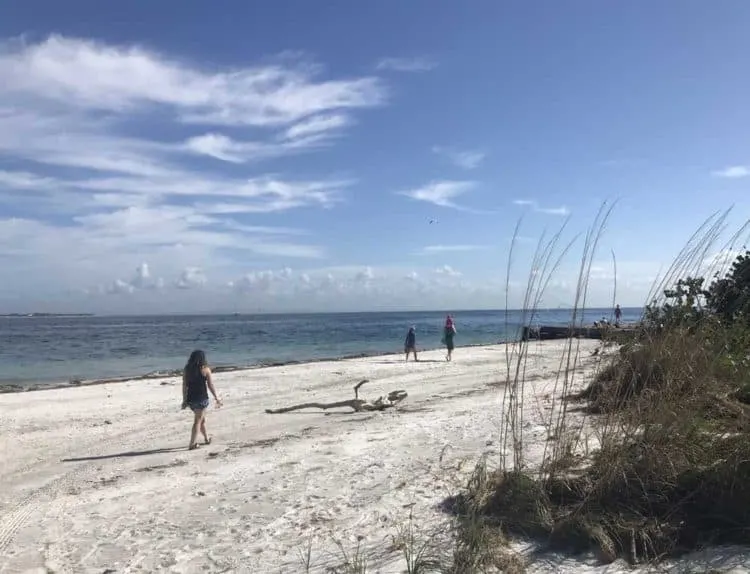
The 49-passenger ferry from Fort DeSoto arrives on the bay side by the lighthouse and you can begin your exploration in any direction. Some people immediately staked out spots on the nearby beach. We started with the trail past the remains of Fort Dade.
The three original Fort Dade batteries are pretty much intact. (Well, one is falling into the Gulf.) Climbing the stairs to the top provides nice views over the sand dunes to see the many shades of blue in Tampa Bay. There are cool thick walled rooms inside the battery in which you can roam. We saw kids quite thrilled to explore this space.
These massive bunkers are built into the ground, designed to be invisible by an attacking navy, who would be raked by fire from their disappearing guns. (The guns “disappear’ when a mechanism allows them to retract into concrete pits after firing. This is a nice trick, made obsolete by the invention of the airplane.)
The guns, however, are gone. Some have been moved to Fort De Soto, the park from which the ferry leaves. (If you are a military history enthusiast, you will want to visit both Fort Dade on Egmont Key and Fort De Soto.)
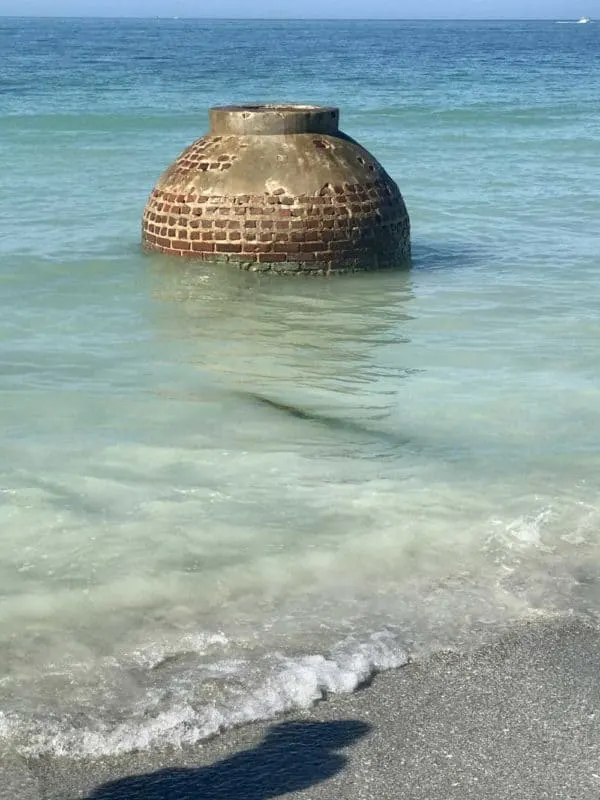
The complex, once an impressive facility, burned to the ground in 1925 in a fire intentionally set by federal agents trying to smoke out rum runners and others.
Today, pathways take you past the three batteries, which you are free to wander and explore. Walking further, you come to the red brick roads through the ghost town of the community built around the fort.
What makes it come alive is the extensive signage identifying what every structure was, from the tennis court for the officers to the morgue.
The only residents now are gopher tortoises and mosquitos. I don’t know if the mosquitos are a year-round presence, but they were vicious at the end of November. Bring bug spray.

Tips for your visit to Egmont Key
If you come by ferry, you have two or three hours so you have to decide your priorities. We chose to walk in the historic fort area and have a picnic on the Gulf beach, but we didn’t have time to look for shells or shark teeth or swim.
We loved our picnic site. It was about a mile from where the ferry lands, on the Gulf-side, next to ruins of the power plant, which are being swallowed by advancing water. We found shade in the trees that line the beach and spread our beach towel on the sand, enjoying the picturesque scene of waves and ruins.
There are picnic tables in a grove of trees not far from where the ferry lands.
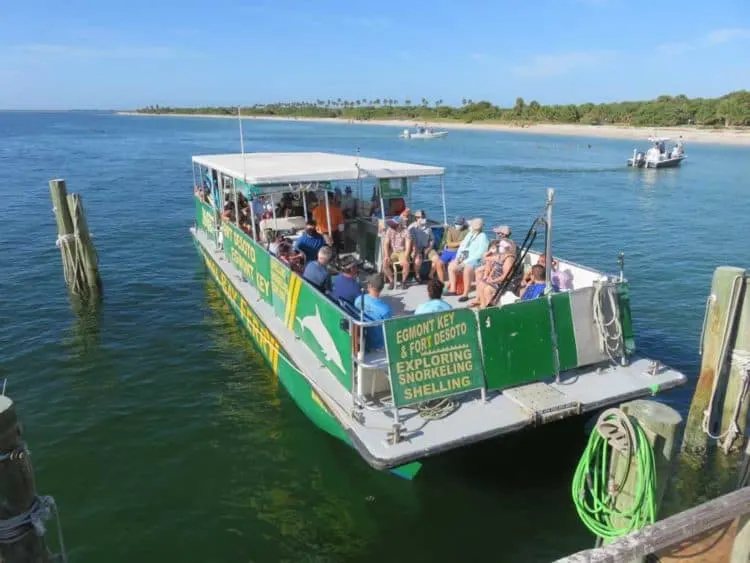
The ferry boat ride from Fort DeSoto is only about 20 minutes, but it is a pleasure, with views of sailboats, the Sunshine Skyway Bridge, the lighthouse on Egmont Key and the skyline of St. Petersburg. (I bet the longer trip from the pier has stunning scenery.)
Wear shoes that can get wet, as you may have to step into the surf getting off the boat on Egmont Key.
You cannot bring alcohol, glass, pets, kites, or drones to the island because it is a wildlife preserve and these items are prohibited.
From spring to fall, Egmont Key is a popular place for snorkeling. Few snorkeled on our late November visit, when Gulf waters were a chilly 68 degrees. You can rent snorkeling gear on the ferry from For tDeSoto.
Can you kayak to Egmont Key? Yes, experienced paddlers with the right kind of kayak in the right weather and knowledge of tides and currents do make the trip. Here’s an excellent kayak trip report.

Egmont Key National Wildlife Refuge
Fort De Soto Park, 3500 Pinellas Bayway S, Tierra Verde, FL 33715. Here’s a FloridaRambler.com story about the park. The park, from which the ferry leaves, has terrific camping, beaches, bike paths and more. It’s worth several hours of exploration.
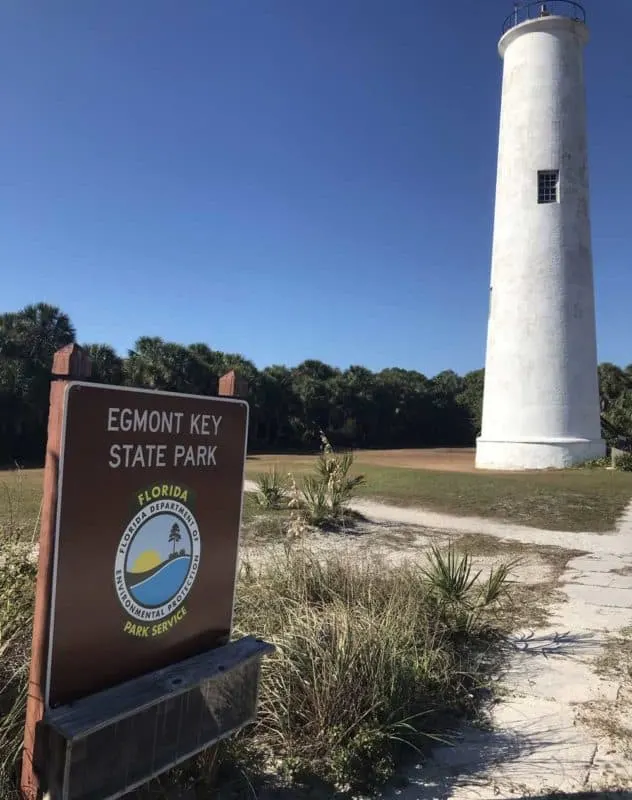
Other things to do near Egmont Key State Park
Here are Florida Rambler stories about things to do nearby:
We loved staying in a vacation rental in a nearby Old Florida beach town, Pass-a-Grille.
Pinellas Trail: On the west side of Tampa Bay is one of the most progressive and appreciated rails-to-trails projects in all of Florida. The 50-mile Pinellas Trail starts in Tarpon Springs and runs south through downtowns and neighborhoods in Dunedin, Clearwater, Largo, Pasadena and into downtown St. Petersburg. There’s a spur north of Dunedin that goes out to beautiful Honeymoon Island. This is a multi-purpose trail for hikers, bikers and roller skaters. Read more in this Florida Rambler article: Treasured St. Pete bike trail.
Finding Old Florida in St. Petersburg: We offer seven things to do in St. Petersburg to discover its historic treasures, from an elegant 1920s hotel to flamingoes in an old roadside garden attraction. Old Florida in St. Petersburg.
St. Pete is a city of museums and art: Here’s our story on the many excellent museums that have opened.
St. Petersburg arts & brew walk: Explore brewpubs and galleries with this detailed guide.
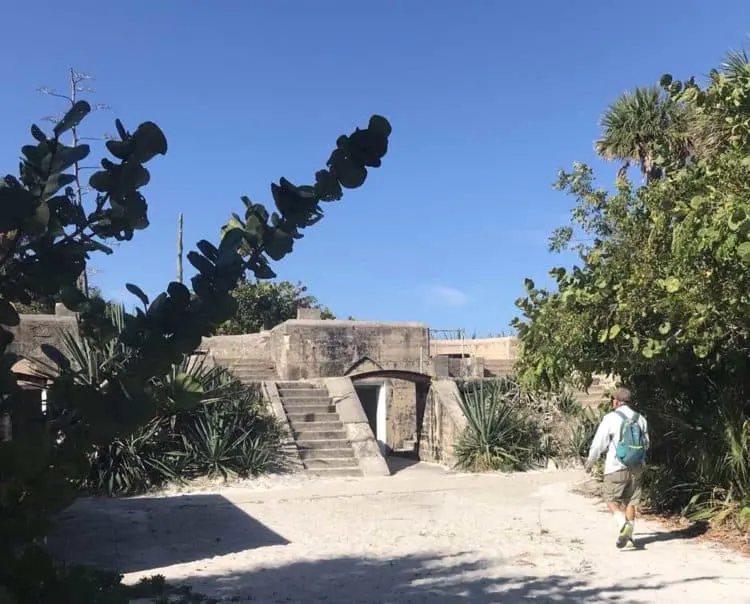
Dunedin: Delightful biking, breweries, beaches & more
Safety Harbor Spa: Healing waters are star of charming town
Best camping near Tampa Bay: 9 choice campgrounds
Paddleboarding Tampa Bay area: 5 awesome destinations
Frog Creek: Little-known Tampa Bay kayak trail
Emerson Point Preserve: Four reasons to discover this jewel in Palmetto
Hillsborough River State Park adds ‘glam’ to its camping options

The author, Bonnie Gross, travels with her husband David Blasco, discovering off-the-beaten path places to hike, kayak, bike, swim and explore. Florida Rambler was founded in 2010 by Bonnie and fellow journalist Bob Rountree, two long-time Florida residents who have spent decades exploring the Florida outdoors. Their articles have been published in the Sun Sentinel, the Miami Herald, the Orlando Sentinel, The Guardian and Visit Florida.

Jeff P.
Wednesday 15th of November 2023
Thanks for the great information. I've got a group heading there around Thanksgiving 2023, so this was very helpful. I'll let you know how it goes!
juelmer
Monday 24th of January 2022
Great article, I found that the prices for the FERRY changed as of January 2022 as follows: Adults(and children 12 and above) $40, children 3-11 $20, infants 2 or less FREE. Seehttps://www.hubbardsmarina.com/egmont-key-ferry-cruise/ The park itself does not have any entry fees: https://www.floridastateparks.org/parks-and-trails/egmont-key-state-park
Bonnie Gross
Monday 24th of January 2022
Thanks so much!
Joyce Kleen
Monday 4th of January 2021
Colleagues shared this interesting article on Egmont Key. Thank you for mentioning the national wildlife refuge, but the refuge is not just the closed areas. The entire island is Egmont Key National Wildlife Refuge and State Park. Egmont Key NWR was established in 1974 and includes the entire island. The state park entered into cooperative management of the island with U.S. Fish and Wildlife Service in 1989. Both agencies, U.S. Fish and Wildlife Service and Florida Park Service cooperatively manage the entire island. Here's 2020 data, for bird nesting: Anywhere from 25,000-48,000 pairs of birds have nested on Egmont Key in the past 10 years. 25,000 pairs nested in 2020 with 20,000 of those being laughing gulls. Other species include royal and sandwich terns, which you mentioned, brown pelicans, black skimmers, and American oystercatchers. Thank you for also mentioning what you cannot bring to the island including pets, alcohol, drones, and kites.
Bonnie Gross
Monday 4th of January 2021
Thanks so much for that additional information. I will clarify this in the story.